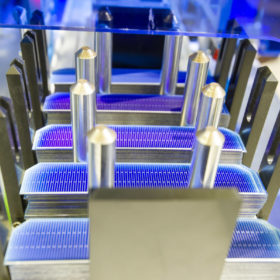Substantial solar gains to be had from clean air – study
Eliminating emissions from the air would increase solar radiation by an average of 11%, allowing solar cells to generate one tenth more electricity claim researchers in a new study. Focusing on China, they say an additional 85-158 TWh of electricity could be generated annually in 2040, if the air was clean.
Solar sector to add 552 GW by 2027 led by China
The leading trio – China, the United States and India – will comprise 70% of the projected 552 GW of solar capacity, which will be added between end-2017 and 2027, finds Fitch Solutions, which has revised down its original forecast for solar capacity growth in China. The curbed growth in China, due to subsidy cuts and restricted access to the United States and India, is expected to squeeze domestic solar equipment manufacturers, but also lead to access to cheaper solar panels in other smaller markets.
China may raise 2020 solar target to over 200 GW
The target of 105 GW of cumulative installed photovoltaic power, which was originally planned to be achieved by the end of the decade, has already been surpassed. PV Info Link now reports that the 2020 solar target may be revised upwards to between 210 GW and 270 GW.
India powers ahead as Asia set for 355 GW of PV by 2023
Despite political hurdles in key markets including China and Japan, Asia remains highly active. This year, 59 GW of solar is expected to be installed and due to further system price declines, a phase-out of subsidy schemes can be offset.
TOPCon: The next big thing after PERC
TOPCon technologies could further increase solar cell efficiencies, said Guangyao Jin, chief scientist, DuPont Photovoltaic Solutions, at this year’s Energy Taiwan, held in September. He added that metallization paste is crucial.
Interview: GoodWe talks IPOs, policy changes and tripling production capacity
In an interview with pv magazine, vice president of GoodWe, Ron Shen, talks about the company’s plans for Germany, Spain, Africa and India, in addition to its goal to triple production capacity to 15 GW in China. He also discusses the effect of China’s 31/5 policy change, and plans for an initial public offering (IPO).
Government focuses on PV quality concerns
The award of the nation’s first solar project quality certificate may signal a renewed determination by the federal authorities to crack down on low-quality panels – with Far Eastern imports firmly in their sights.
Funding the key obstacle to renewables in Asia
Banks categorize renewable energy projects as risky and believe they offer lower rates of return than fossil fuel schemes, making them reluctant lenders.
Solar Imports: India defers safeguard duty, provides relief to ongoing projects
Even though postponing the duty on solar cell imports from China and Malaysia is not a long-term resolution, it will offer relief to developers with ongoing PV projects, especially for those with shipments in transit or which arrived after 30 July.
Court to hear Vikram Solar’s safeguard duty petition next week
The Government of India will also consider changes to the 25% safeguard duty imposed on solar cell imports from China and Malaysia only after the next hearing in the Odisha High Court, which stayed the levy.













